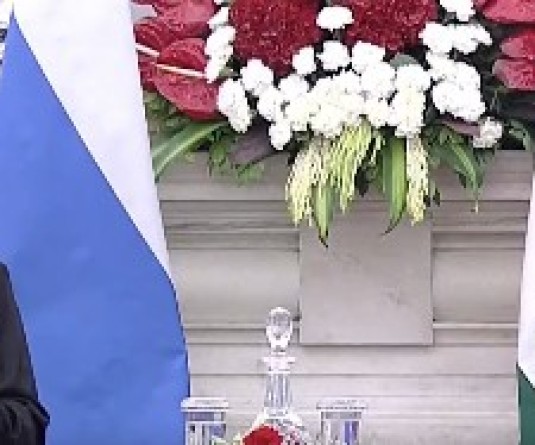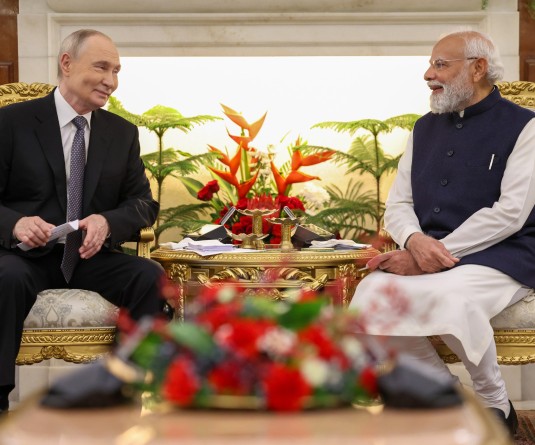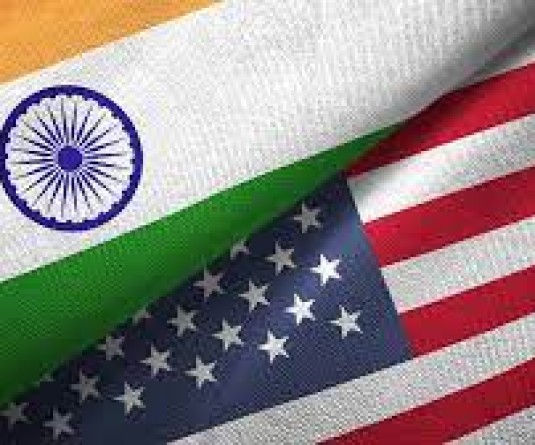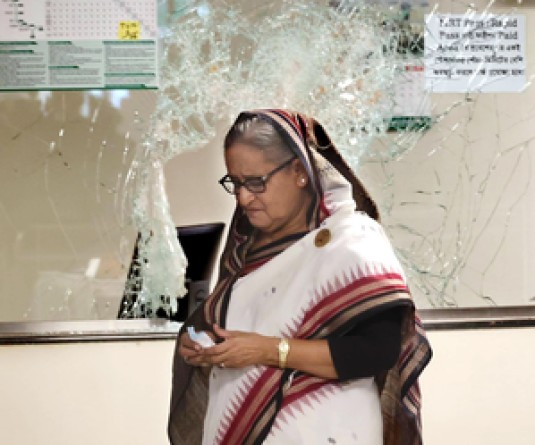
Cecile Blumental, nee Schrouben, friend of Henri Huet, stands next to a photograph of Henri Huet, at the 'Henri Huet, Vietnam' exhibition at the Maison Europeenne de la Photographie, MEP, in Paris, Tuesday, February 8, 2011. The exhibition commemorates AP Photographer Henri Huet's work during the Vietnam war before he perished when his helicopter was shot down over Laos. The Exhibition ends on April 10, 2011. (AP Photo)
PARIS , February 13 (AP): It was a love token worn through the blood-drenched rice paddies and jungles of the Vietnam War. For Henri Huet, the Virgin Mary medallion was his one constant link to Cecile, the woman he loved. The celebrated Associated Press photographer carried it in his pocket or hung it around his neck. It was engraved for her baptism and when he left for the war, she gave it to him. On assignment, the military helicopter Huet was riding in got shot down over Laos. Huet was killed. The medallion the size of a penny disappeared into the thickness of a bamboo forest, where it slept for nearly three decades. This past week, the gold medallion was again in the hands of Cecile, the culmination of an extraordinary journey that took it across epochs and continents - and whose mystery was unlocked by a long-lost trove of letters.
Their story started with an apple grabbed for lunch outside New York’s Rockefeller Center. The 20-year-old Cecile Schrouben was about to bite into it when Huet approached her and told her it was no proper meal. He suggested oysters instead, a nod to the rocky coast of Brittany, where he grew up. The lanky man with a roguish grin was irresistibly charming. He was at AP headquarters, recovering from a leg injury suffered in Vietnam. She was an AFP archivist, receptionist and general gopher. They jetted off to Mexico, where Huet took her under his wing and taught her photography. Duty called in 1968: Huet was sent back to cover the war.
He wanted her to join him in Asia - but not in war-ravaged Vietnam. Parting, she gave him the medallion - a baptismal gift from her godmother, in keeping with Roman Catholic tradition. They wrote each other letters, hundreds of them. The correspondence lasted nearly three years. She wrote her last letter the day he died.
It was Feb. 10, 1971. Huet, 43, had boarded a South Vietnamese military helicopter in the town of Khe Sanh, near the border with Laos, with a mission to inspect efforts by U.S.-backed forces to sever Viet Cong supply lines. With him were three other legendary news photographers: Larry Burrows of Life magazine, Kent Potter of United Press International and Keisaburo Shimamoto of Newsweek. In a flash of anti-aircraft fire, the chopper was gunned down. All four photographers were killed, along with seven Vietnamese troops, one of them a military photographer.
Along with the men, the camera equipment, and the military hardware, a tiny disc of gold also tumbled down from the skies above Laos. On one side was a relief of the Virgin Mary; on the other was etched, “Cecile, nee le 16-6-1947” - French for “born on June 16, 1947.” For 27 years, the keepsake lay on an overgrown Laotian hillside. A U.S. search team found the crash site four years later. In 1998, a U.S. Army forensic team traveled to the site. Former AP Saigon Bureau Chief Richard Pyle and AP photographer Horst Faas were on hand for the start of the search. The team, staffed with Laotian locals, found camera parts, broken watches, bits of wreckage - and the tiny cameo.
Pyle suspected it belonged to Huet because of the French. But he’d never heard the photographer speak about a Cecile, and a search of AP archive photos didn’t turn up Huet wearing the medallion. With no proof of ownership, the medallion stayed in U.S. Army storage. Until a woman came forward with a mysterious packet of letters. In 2004, Helene Gedouin, an editorial director at French publishing house Larousse, came across “Requiem,” a book by Faas about photographers like Huet who were killed in action in Vietnam and Indochina. The book inspired her to delve deeper into the life of Huet, who was a relative of hers through marriage. She met Faas, and two years later they co-authored a book on Huet. In the fall of 2006, upon return from a photojournalism conference in the south of France, Gedouin found an email in her inbox. “Hello, I have nothing to do with Henri Huet,” the message read, “but it turns out - by the greatest happenstance - that I have in my possession a correspondence from Henri Huet that he wrote to a woman. They are love letters, and there are about 400 of them. I’d like to meet you.”
The letters were addressed to a Cecile Schrouben. In one of them, he mentioned a small town in Belgium where she was born. Gedouin went through the local phone directory, called all the Schrouben households she could find - and in the fourth call, found Cecile’s brother.
“I said, ‘could you call your sister and tell her that we have something in our possession that she had lost?”’ Gedouin recalled. “The next day, she called me.” The letters were all the proof the U.S. military needed to release the medallion. Pyle got in touch with American authorities after learning about the letters from Gedouin.
“When I called the (U.S. Army) laboratory director in Hawaii and told him this, he was ecstatic,” Pyle recalled. “He said: ‘That’s it, that’s the final proof. That’s what we needed.”’
Larry Burrows’ son Russell, as a relative of a crash victim and one who has had repeated contacts with the U.S. military about recovering items lost, was sent the medallion in a Federal Express parcel last fall. Cecile told AP she had stored the letters in a box in a Paris apartment. A young man who had helped the new owner move in noticed them. Intrigued by the epistolary romance, he gave them to his mother for safekeeping. Why the woman came forward after holding on to the letters for 15 years remains a mystery. Gedouin declined an AP request that she provide a way to contact the woman. Huet was born in Dalat, Vietnam, in 1927, the second son of four children to a high-society Vietnamese mother and a French civil engineer for France’s colonial government in Indochina. Pyle has described Huet as one of “the three finest people that I ever met in my life;” Cecile calls him one of the two “best” people she has known.
Their story started with an apple grabbed for lunch outside New York’s Rockefeller Center. The 20-year-old Cecile Schrouben was about to bite into it when Huet approached her and told her it was no proper meal. He suggested oysters instead, a nod to the rocky coast of Brittany, where he grew up. The lanky man with a roguish grin was irresistibly charming. He was at AP headquarters, recovering from a leg injury suffered in Vietnam. She was an AFP archivist, receptionist and general gopher. They jetted off to Mexico, where Huet took her under his wing and taught her photography. Duty called in 1968: Huet was sent back to cover the war.
He wanted her to join him in Asia - but not in war-ravaged Vietnam. Parting, she gave him the medallion - a baptismal gift from her godmother, in keeping with Roman Catholic tradition. They wrote each other letters, hundreds of them. The correspondence lasted nearly three years. She wrote her last letter the day he died.
It was Feb. 10, 1971. Huet, 43, had boarded a South Vietnamese military helicopter in the town of Khe Sanh, near the border with Laos, with a mission to inspect efforts by U.S.-backed forces to sever Viet Cong supply lines. With him were three other legendary news photographers: Larry Burrows of Life magazine, Kent Potter of United Press International and Keisaburo Shimamoto of Newsweek. In a flash of anti-aircraft fire, the chopper was gunned down. All four photographers were killed, along with seven Vietnamese troops, one of them a military photographer.
Along with the men, the camera equipment, and the military hardware, a tiny disc of gold also tumbled down from the skies above Laos. On one side was a relief of the Virgin Mary; on the other was etched, “Cecile, nee le 16-6-1947” - French for “born on June 16, 1947.” For 27 years, the keepsake lay on an overgrown Laotian hillside. A U.S. search team found the crash site four years later. In 1998, a U.S. Army forensic team traveled to the site. Former AP Saigon Bureau Chief Richard Pyle and AP photographer Horst Faas were on hand for the start of the search. The team, staffed with Laotian locals, found camera parts, broken watches, bits of wreckage - and the tiny cameo.
Pyle suspected it belonged to Huet because of the French. But he’d never heard the photographer speak about a Cecile, and a search of AP archive photos didn’t turn up Huet wearing the medallion. With no proof of ownership, the medallion stayed in U.S. Army storage. Until a woman came forward with a mysterious packet of letters. In 2004, Helene Gedouin, an editorial director at French publishing house Larousse, came across “Requiem,” a book by Faas about photographers like Huet who were killed in action in Vietnam and Indochina. The book inspired her to delve deeper into the life of Huet, who was a relative of hers through marriage. She met Faas, and two years later they co-authored a book on Huet. In the fall of 2006, upon return from a photojournalism conference in the south of France, Gedouin found an email in her inbox. “Hello, I have nothing to do with Henri Huet,” the message read, “but it turns out - by the greatest happenstance - that I have in my possession a correspondence from Henri Huet that he wrote to a woman. They are love letters, and there are about 400 of them. I’d like to meet you.”
The letters were addressed to a Cecile Schrouben. In one of them, he mentioned a small town in Belgium where she was born. Gedouin went through the local phone directory, called all the Schrouben households she could find - and in the fourth call, found Cecile’s brother.
“I said, ‘could you call your sister and tell her that we have something in our possession that she had lost?”’ Gedouin recalled. “The next day, she called me.” The letters were all the proof the U.S. military needed to release the medallion. Pyle got in touch with American authorities after learning about the letters from Gedouin.
“When I called the (U.S. Army) laboratory director in Hawaii and told him this, he was ecstatic,” Pyle recalled. “He said: ‘That’s it, that’s the final proof. That’s what we needed.”’
Larry Burrows’ son Russell, as a relative of a crash victim and one who has had repeated contacts with the U.S. military about recovering items lost, was sent the medallion in a Federal Express parcel last fall. Cecile told AP she had stored the letters in a box in a Paris apartment. A young man who had helped the new owner move in noticed them. Intrigued by the epistolary romance, he gave them to his mother for safekeeping. Why the woman came forward after holding on to the letters for 15 years remains a mystery. Gedouin declined an AP request that she provide a way to contact the woman. Huet was born in Dalat, Vietnam, in 1927, the second son of four children to a high-society Vietnamese mother and a French civil engineer for France’s colonial government in Indochina. Pyle has described Huet as one of “the three finest people that I ever met in my life;” Cecile calls him one of the two “best” people she has known.






